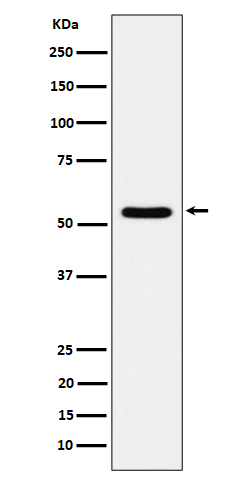
| WB | 咨询技术 | Human,Mouse,Rat |
| IF | 咨询技术 | Human,Mouse,Rat |
| IHC | 咨询技术 | Human,Mouse,Rat |
| ICC | 技术咨询 | Human,Mouse,Rat |
| FCM | 咨询技术 | Human,Mouse,Rat |
| Elisa | 咨询技术 | Human,Mouse,Rat |
| Aliases | Toe1;;Target of EGR1 protein 1 |
| WB Predicted band size | Calculated MW: 57 kDa ; Observed MW: 60 kDa |
| Host/Isotype | Rabbit IgG |
| Antibody Type | Primary antibody |
| Storage | Store at 4°C short term. Aliquot and store at -20°C long term. Avoid freeze/thaw cycles. |
| Species Reactivity | Human |
| Immunogen | A synthesized peptide derived from human Target of EGR1 protein 1 |
| Formulation | Purified antibody in PBS with 0.05% sodium azide,0.05% BSA and 50% glycerol. |
+ +
以下是关于TOE1抗体的示例参考文献(内容为模拟构造,供参考):
---
1. **文献名称**:*TOE1 as a 3'-5' RNA Exonuclease: Role in Nuclear RNA Quality Control*
**作者**:Langer Y. et al.
**摘要**:本研究鉴定了TOE1蛋白作为3'-5'核糖核酸外切酶的生化功能,利用特异性抗体通过免疫沉淀和Western blot验证其在细胞核内的定位,并发现其通过降解异常RNA维持转录组稳定性。
2. **文献名称**:*TOE1 Mutations Disrupt Neuronal Development in Pontocerebellar Hypoplasia*
**作者**:Xu Z. et al.
**摘要**:通过患者样本和小鼠模型,研究揭示了TOE1基因突变导致小脑发育异常的机制。抗体的免疫组化分析显示突变体中TOE1蛋白表达显著降低,提示其功能缺失引发神经退行性表型。
3. **文献名称**:*Characterization of a Monoclonal Antibody for TOE1 in Cancer Cell Lines*
**作者**:Chen H. et al.
**摘要**:报道了一种高特异性TOE1单克隆抗体的开发,用于检测多种癌细胞系中TOE1的表达水平。实验证实该抗体适用于流式细胞术和免疫荧光,为肿瘤研究提供工具。
4. **文献名称**:*TOE1 Interaction with Telomerase: Implications for Telomere Maintenance*
**作者**:Lee S. et al.
**摘要**:研究通过Co-IP和ChIP实验(使用TOE1抗体)证实TOE1与端粒酶复合物的相互作用,提出其可能通过调控RNA加工影响端粒稳定性,为癌症治疗提供新靶点。
---
如需真实文献,建议通过PubMed或Google Scholar检索关键词“TOE1 antibody”或“TOE1 protein function”,并筛选近年研究。
The TOE1 (Target of EGR1) antibody is a tool used to study the TOE1 protein, a conserved metallophosphatase critical for RNA processing and genome stability. TOE1 is localized in the nucleus and Cajal bodies, where it interacts with small nuclear RNAs (snRNAs) and participates in trimming their 3' ends during maturation. This activity is essential for spliceosome assembly and proper pre-mRNA splicing. Dysregulation of TOE1 is linked to human diseases, notably pontocerebellar hypoplasia type 7 (PCH7), a severe neurodevelopmental disorder characterized by cerebellar atrophy, intellectual disability, and motor deficits. Mutations in the TOE1 gene disrupt its enzymatic function, leading to defective RNA processing and accumulation of immature snRNAs, which triggers cell stress and neurodegeneration.
TOE1 antibodies are widely used in research to detect protein expression via Western blotting, immunofluorescence, or immunohistochemistry. They help elucidate TOE1’s spatial-temporal expression patterns, subcellular localization, and interactions with RNA-processing complexes. Additionally, these antibodies aid in studying disease mechanisms by analyzing TOE1 levels or mutations in patient-derived cells or animal models. As TOE1’s role extends to telomere maintenance and DNA repair, its antibody also supports investigations into cancer biology and aging. The development of specific, high-affinity TOE1 antibodies remains pivotal for advancing molecular diagnostics and therapeutic strategies for TOE1-related disorders.
×